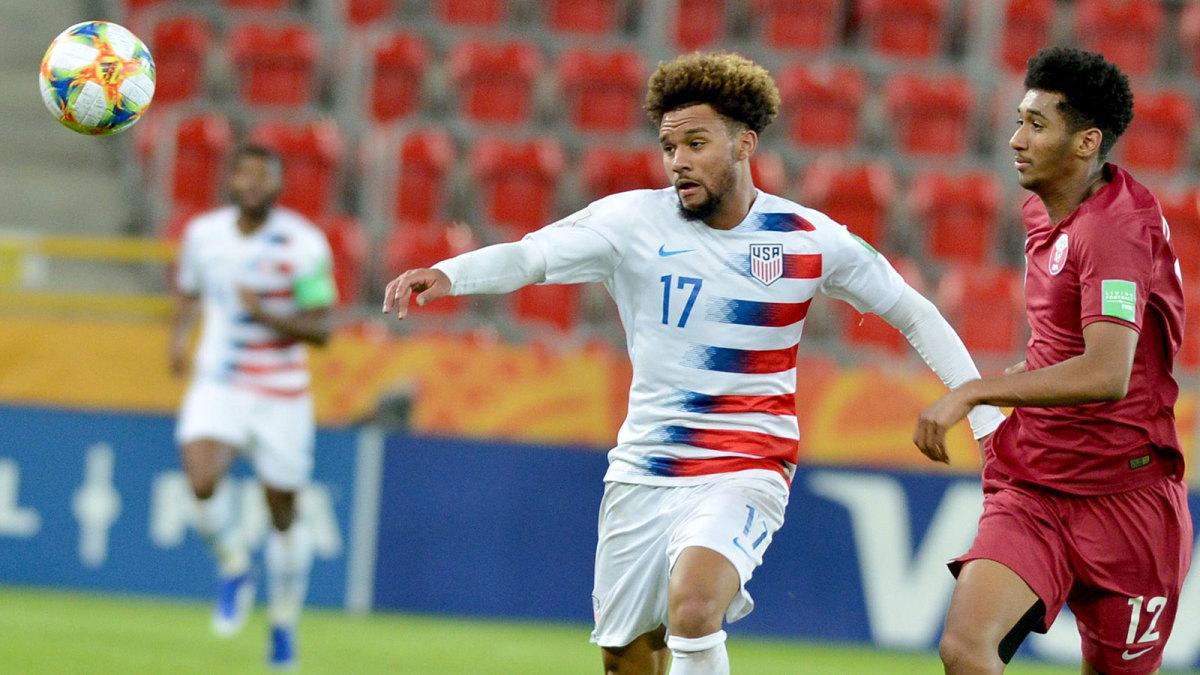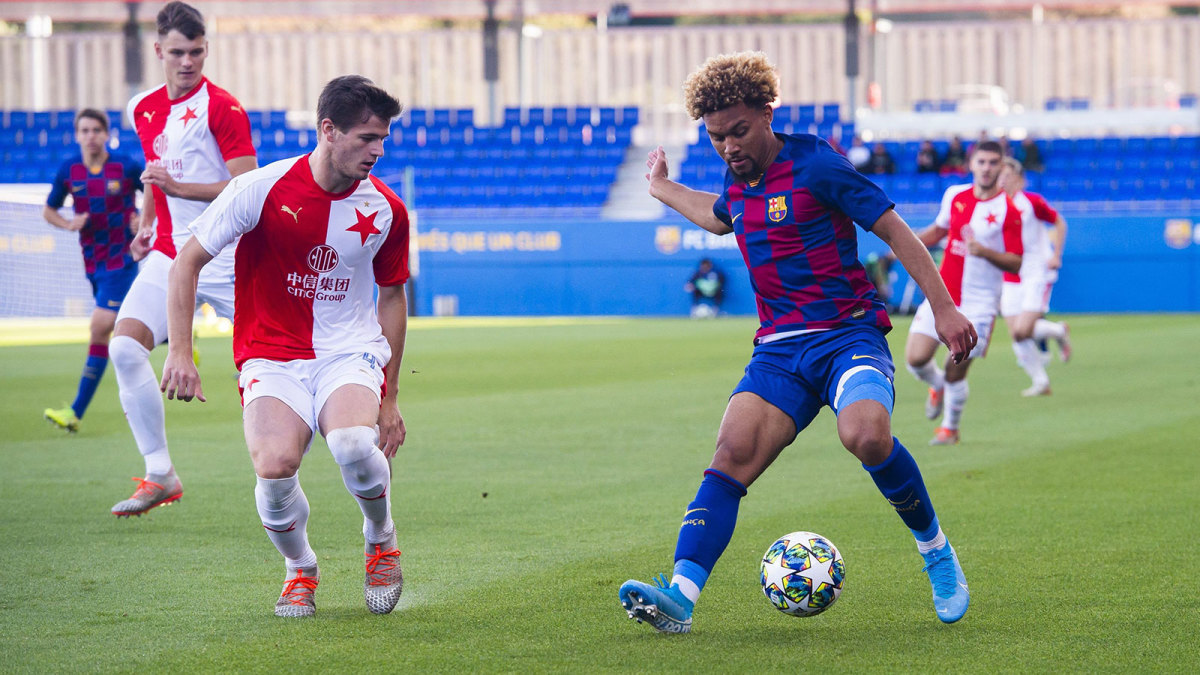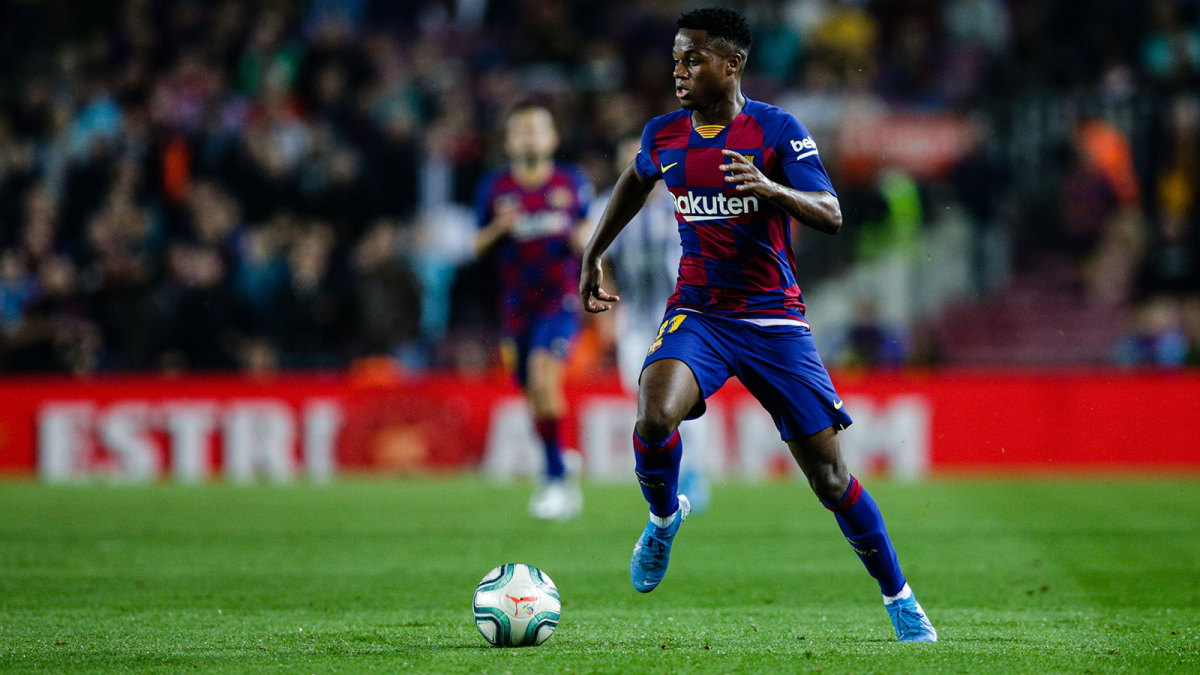An American at Barcelona: Konrad de la Fuente's La Masia Experience and Outlook

He is the American at Barcelona, the proud owner of a golden ticket at La Masia, the Hogwarts of sports. Miami-born left winger Konrad de la Fuente is 18 now, but he has lived in Spain with his family for eight years and has been part of Barcelona’s youth academy since he was 12.
As Barça celebrates the 40th anniversary of La Masia, which has produced such talents as Lionel Messi, Xavi, Andrés Iniesta and so many others, de la Fuente is trying to rise through the ranks like they did. The process goes day by day, game by game.
“Ever since I was a U-17, we’ve trained in the morning,” de la Fuente told SI.com. “So for the past like three years now, I’ve been training in the morning, and then in the afternoon I do schoolwork every day.”
After being one of the youngest players on the U.S. team that reached the quarterfinals of this year’s Under-20 World Cup, de la Fuente—or simply “Konrad,” as he’s known in team lineups—is playing for Barça’s Juvenil A team this season, one step below Barcelona B, which is one step below the first team. One of the people who’s watching over him is Patrick Kluivert, the former Barcelona striker who took over the club’s youth academy earlier this year.
“I’ve spoken quite a few times with Konrad,” Kluivert told SI.com. “I think Konrad is a very bright player. He has a very good one-on-one action. He needs to score more, but as I say that in the last three games he has scored four goals, so that’s a good thing. I think when he continues like this next year, he will be for sure in the Barça B team.”

Tab Ramos, who coached de la Fuente on the U.S. U-20 team, said: “For me, Konrad was just a player who seemed to be ahead of most other players in terms of the tactical side of the game. He really understood the winger position in a 4-3-3. He played the position well. He’s a risk-taker and a playmaker, and that for me made him a really special player.”
De la Fuente’s U.S. team upset France in the Under-20 World Cup round of 16, but the Americans went out against Ecuador in the quarterfinals.
“Honestly, we should have won the whole tournament, I’m not going to lie,” de la Fuente said. “We just didn’t have a good game against Ecuador, and we lost. But we were good enough to win it.”
Born to a Haitian-American family in Florida, Konrad moved with his parents, Conrad and Jennifer, and his younger brother, Richard, to Madrid in 2011 so that his father could take a job as a commercial attache in the Haitian embassy there. Soon after arriving, Konrad tried out for a youth club in Barcelona and moved there with his mother and brother. Two years later, Barça scouted him and asked him to join the youth academy—where he became the second American ever at La Masia after Ben Lederman (who was there from 2011 to 2014.)
Unlike some young players at La Masia, who board on-site at the facility, de la Fuente lives with his family in an apartment in the city.
“I’m really thankful,” he said, "and just trying to work hard every day to get to the first team.”
If he can do that, he’ll be part of an ongoing effort at the club under Kluivert to show that La Masia can be just as influential today as it has been over the past 40 years.

********
“La Masia still matters,” says Kluivert. “La Masia is our core. We need to develop a lot of talented players. Of course, not every individual player is going to reach the first team, but we need to guide the players to follow their dreams. And also a piece of luck has to combine as well with the skill of the individual player. If you have an injury [in the first team] and a good player is in the right position at the right time and he takes his change, the chance that he will be closer to the first team is bigger. It’s all about preparing the youngsters for the first team—and when they have the chance to fit in very smoothly.”
When the Barcelona board hired Kluivert earlier this year, it was looking for someone who could serve as a symbol, not just with Barça’s fans but with the young players at La Masia as well.
Said Xavier Vilajoana, the board member who oversees La Masia, “It’s so important for us to have a figure like Patrick, who comes from a similar philosophy of Ajax to having been a very good player on the [Barça] first team for many years. The young men need a reference, someone who they can watch and say, ‘Wow, he has been a great player, and the philosophy from Ajax and Johan Cruyff is the same.’”
But there is a challenge, too. It would be unrealistic to expect that Barcelona will ever have three La Masia graduates be the three finalists for the world player of the year award in the same year, as Messi, Xavi and Iniesta were in 2010. But La Masia could have a bigger impact on the first team than it has had in recent years. The recent purchases of 22-year-old midfielder Frenkie de Jong (for $85 million) and 23-year-old midfielder Arthur (for $50 million) have shown that the club felt it had to spend big on transfers in spots that in years past might have gone to La Masia products.
“You’re talking about two great midfielders,” Kluivert said of De Jong and Arthur. “If you don’t have the midfielders all directly ready to play in the first team, you need to find them. We spent a lot of money to buy those kinds of players, and they are worth what we spent. But the most convenient thing for us as the Barcelona youth academy is to develop the players so that they can take the place of the players who we want to buy.”

This season, Ansu Fati and Carles Pérez are two La Masia players who have found playing time with the Barça first team, and both Kluivert and Vilajoana refer to them when asked about La Masia’s continued ability to produce talent. That said, Riqui Puig and Carles Aleña have yet to break through, and La Masia has seen several promising talents move to other clubs, such as Xavi Simons (to PSG), Mateu Morey and Sergio Gómez (to Dortmund), Eric Garcia and Adrián Bernabe (to Man City) and Robert Navarro (to Monaco). Barça did manage to hold onto Ilaix Moriba, another promising player who was considering a move elsewhere.
If you ask Kluivert how he plans to put his personal stamp on the Barça youth academy, this is what he says: “When I started, I had a look at what we already have, and what can I improve? My personal stamp is not letting the qualities and the talented players leave this easy, because in the past we had lost some great talents to other clubs, and it’s important to keep them in the club … I also want to put my stamp on nutrition for the players, the capturing of talents and detecting talents from an early age. Here in Catalonia we have great talents, but they need to be detected, and after that the coaches need to do a good job to get everything out of the talent of the players.”
One thing is crystal clear with Kluivert, however: Barcelona won’t be changing any of its philosophy when it comes to developing players. Yes, it’s true that the modern game is faster and more physical, and yes, it’s true that midfielders like Rodri (Man City via Atlético Madrid), Thomas Partey (Atlético) and Tanguy Ndombele (Tottenham via Lyon) fit that profile better than the traditional hyper-skillful but not particularly physical Barcelona-produced midfielder. But Barça has stuck to its guns before and continued to benefit.
“The philosophy stays the same,” said Kluivert. “It depends of course on what kinds of players you want in what kinds of positions. But first of all, the technical and intellectual skills: We need to have skillful players. Our game is letting the ball do the work.”
As Vilajoana put it, “Our model is based on a very quick movement of the ball and the talent of the players. No one can run faster than the ball. If you have talent and also you are physically strong? O.K., it’s good. But it’s not common. To be talented in general you are not tall, you are more small. But you have to move quickly.”
It’s a style that fits Konrad de la Fuente, who’s proof positive that playing for Barcelona at La Masia does indeed involve having the most ambitious dreams possible. If you ask him what he wants to achieve in his career, he doesn’t hesitate to tell you.
“In the near future, I want to become a professional player as soon as possible,” he said. “In the long term, I want to win a World Cup with the USA and be the best player in the world.”
